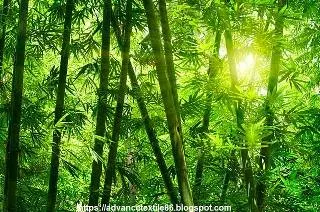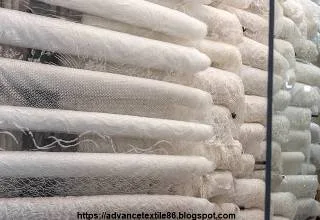Plant fiber has always been a clear contributor to economic prosperity and sustainability in our lives because of its application in almost everything we use in our daily routines. There is a growing demand for more comfortable and eco-friendly products and to satisfy them, textile researchers are focusing on renewable and biodegradable sources and eco-friendly processes. Among natural fibrous plants, bamboo is by far the most popular, due to its versatile application and its significant contribution to the environment.
Bamboo textiles
Bamboo
textiles are any fabric, yarn, or garment made from bamboo fiber. Although
historically used only for structural elements, such as bustles and corset
ribs, various technologies have been developed in recent years that allow bamboo
fiber to be used for a wide range of textile and fashion applications. Different
textile products are made from bamboo fabric like shirt tops, pants, and socks for
adults and children, as well as sheets and pillow covers. Bamboo yarn can be
mixed with other textile fibers such as hemp or spandex.
Bamboo
is an alternative to plastic that is renewable and can be replenished at a
faster rate. Modern clothing labeled bamboo is usually made of viscose rayon, a
fiber that dissolves cellulose in bamboo and is then extracted to make fiber.
This process removes the natural properties of bamboo fiber, making it
identical to rayon from other cellulose sources.
The
main components of bamboo fibers are cellulose, hemicellulose, and lignin. The
secondary ingredients of bamboo fibers are resin, wax, and inorganic salt. It
contains other organic matter besides cellulose and lignin. It contains
cellulose(70-74)%, hemicellulose(12-14)%, lignin(10-12)%, and others like
protein, pectin, and wax (2-3)%.
History of Bamboo Textiles
Bamboo
has a deep connection with the culture of China and Southeast Asia. The Chinese
planted and used bamboo about 7,000 years ago. It was used for food, clothing,
transportation, shelter, musical instruments, and weapons. Bamboo strips were
used as the most important writing medium for materials widely used with silk,
animal fur, and other things like stone. The first books in China were made
with bamboo strips on strings. The earliest record of a U.S. patent on bamboo
fiber dates back to 1864 by Philipp Lichtenstadt. His idea was to introduce a
useful process for breaking bamboo fibers to be used to make rope, fabric,
mats, or paper pulp. In 1881, another patent included blending the bamboo fiber
with wool, but it did not go into mass production due to the fact that it could
include expensive processing methods. In the early 2000s, Beijing University
published the results of the conversion of bamboo fiber into usable fabric. In
2002, bamboo fiber was first made by Hebei Jigao Chemical Fiber Company.
Bamboo textile characteristics
i. Bamboo
fiber has many excellent properties that make it ideal for textile processing.
This makes it breathable and cool to wear. It is incredibly hydrophilic,
absorbing more water than other conventional fibers such as cotton and
polyester.
ii.
It is very durable to grow because it does not require the use of pesticides
and grows very fast under favorable conditions. Its fabric may have an
anti-bacterial property that maintains the fabric, which means the bamboo
fabric does not require the use of chemically antibacterial agents.
iii.
Bamboo textiles are more antistatic than other types of fabrics and have
natural deodorizing properties when it comes to odors.
iv.
It has a thin and whitish degree close to ordinary fine-bleached viscose and
has strong durability, stability, and firmness.
v.
Bamboo fiber textiles are made from bamboo pulp fiber. It is characterized by
good hydrophilic properties, excellent permeability, soft feeling, ease of
straightening and dyeing, and great coloring effect of pigmentation.
vi.
It has strength like steel. It is a soft and beautiful fabric similar to rayon.
This durable ingredient has a natural luster and inherent anti-microbial
properties that help keep you odorless. Bamboo is an incredibly durable asset
because it is fast-growing and resilient.
vii.
The bamboo fiber resembles cotton in its unspun shape, light puffball,
airy fibers. For making bamboo fiber, the bamboo is heavily pulped until it
separates into a thread of thin material of fiber, which can be spun and dyed
for weaving into fabric.
How is a bamboo textile made?
When
regenerated bamboo viscose fiber is required for end-use, the stems of bamboo
should be freed from lignin and hemicellulose. Several techniques such as acid
or alkaline pretreatment, wet oxidation, steam pretreatment, and ammonia fiber
blasting have been explored by various researchers. The basic idea is to cook
bamboo leaves and woody stems in these powerful chemical solvents and then do alkaline
hydrolysis combined with multi-phase bleaching. The process is similar to the
conventional viscose production process.
i. Chemical
process
To
make regenerated bamboo or bamboo viscose fibers, hard bamboo stem leaves and
inner pith are extracted, crushed, and soaked in sodium hydroxide (NaOH)
solution. The alkali cellulose that is formed in the process is pressed by the
excess solution to create more area for easy processing of cellulose. Then, the
pieces of cellulose are kept open so that it dries in the presence of ambient
oxygen. Subsequently, carbon disulfide is added to the cellulose so that
gelling occurs; and its excess is removed by evaporation. Later, it is ripened,
filtered, degassed, and finally, the bamboo viscose is wet-spun, i.e., through
the tip of spinneret nozzles into a dilute sulfuric acid solution, where the
cellulose sodium xanthate hardens and is re-converted-to-bamboo viscose. In
other words, sulfuric acid behaves like a quenching solution that allows the
strands to solidify into the fiber and is, therefore, able to spin into a yarn.
Process sequence-
i.
At first, bamboo leaves and inner core are extracted from bamboo and crushed
ii.
An alkaline solution is made by soaking crushed bamboo in a solution of 20%
NaOH at 20℃ for 3
hours.
iii.
Soda cellulose is crushed by a grinder and left to dry for 24 hours.
iv.
CS2 is added to soda cellulose to sulfurize the compound and turn it
into jelly
v.
The remaining CS2 is evaporated and removed by making sodium
cellulose Xanthate
vi.
NaOH is added with sodium cellulose xanthate to make a viscose solution
containing about 5% NaOH and 7% to 15% bamboo fiber cellulose.
vii.
The high-viscosity bamboo solution is then pressed through the spinneret
nozzles into a large container of a diluted H2SO4 solution.
viii.
It hardens into fibers that are spun into yarns.
ix.
Then it is weaved into fabric/textile.
ii. Mechanical process
The
highest quality bamboo fabric is made with production practices that do not
extract cellulose. Instead, a natural enzyme is used in crushed bamboo wood
fibers, and these fibers are washed to make yarn. These yarns usually have a
silky texture, and the fabric made by this process is sometimes called bamboo
linen. When bamboo fabric is made in this way, it is not environmentally harmful
and the resulting textile is strong and durable. However, most types of bamboo
fabric are not made by this mechanical process.
Bamboo textile's environmental impact
Concerns
have been raised about the environmental friendliness of the chemical route of
bamboo viscose fiber production. Carbon disulfide is known as toxic, resulting
in a threat to factory workers, as well as polluting the environment through
air emissions and wastewater. In most industries, its recovery is only about 50
percent. Also, sodium hydroxide and sulfuric acid also fall into the category
of potentially hazardous chemicals. One remedy is to choose a process similar
to the lyocell process used to make Tencel. Here, N-methyl morpholine-N-oxide is
used as a solvent and hard baths are usually water-methanol solutions, both
non-toxic. Also, since the process is closed-loop, 99.5 percent of the
chemicals used are recycled, emitting only fraction marks in the environment.
However,
bamboo fabrics have exploded in the market on the basis of false environmental
claims that bamboo is an alternative to cotton, silk, and polyester. Customers
were persuaded to spread fraudulent information about bamboo viscose fabric.
Furthermore, soft touch and silk-like drapes tempted customers who were unaware
of the use of toxic chemicals to process hard cellulose bamboo plants into soft
fibers. Considering this information, the US Federal Trade Commission has
imposed strict guidelines for manufacturers: A product cannot be labeled as
bamboo unless it is made from mechanically processed bamboo. It should be
called ‘bamboo viscose’ or ‘bamboo rayon’ if it is made with cellulose
reproduced from bamboo stalks.
Bamboo textile benefits
i.
Bamboo textile has moisture-wicking properties.
There is no chemically treated garment that can outperform a bamboo
piece. It is naturally moisture-wicking
because of the natural bamboo fibers. As bamboo grows in hot and humid
climates, the plant can retain moisture and help it grow. Bamboo is the fastest-growing tree in the world and requires a lot of water to grow that fast.
ii.
Bamboo textiles are naturally odor-resistant. Because it is not treated with
chemicals, natural fibers can prevent odors. Bamboo has antibacterial
properties, which allow it to resist mold and mildew, which can otherwise ruin
a part of the garment. Bamboo textile clothing will always smell fresh and
clean no matter what kind of workout it is facing.
iii.
Bamboo textile is naturally UV protective and has a safety rating of 50+
without the use of chemicals and this protection lasts no matter how often it
is washed.
iv.
Its fabric is hypoallergenic. When we make fabric from bamboo, we don’t have to
use chemicals or mix it with lots of heavy synthetic fibers to create the
functionality you need from your clothing. For example, you will not find
ingredients in bamboo cloth that will irritate your sensitive skin.
v.
Its fabric is a climate control wonder. Bamboo fibers are naturally very
porous, and there are small gaps between the fibers that allow air to flow
freely in and out. This natural ventilation system allows the bamboo fabric to
be the best heat-regulating fabric in the world.
vi.
It has a positive impact on global environmental concerns such as water
scarcity, deforestation, soil erosion, and the greenhouse effect. It is a much
more durable textile than cotton available to help create a developed world.










0 Comments